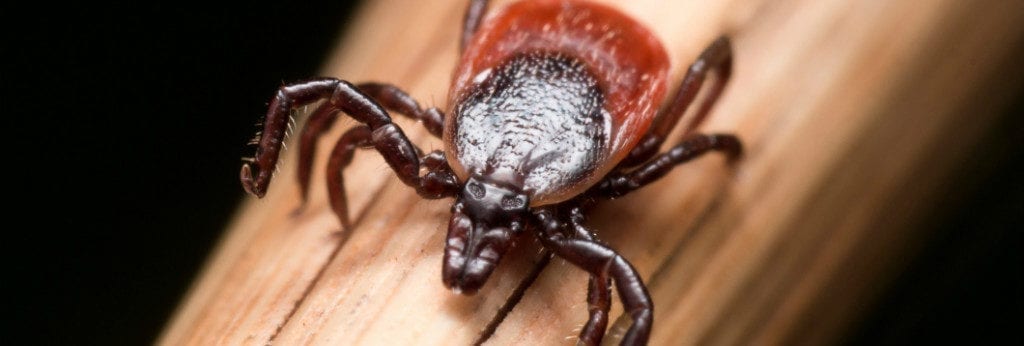
What is a Tick?
Ticks are arachnids that carry a host of diseases. Most people think that these pests are only found in wooden areas, but they can also live in your own yard too, especially if yours is damp, shady, and has a lot of leaf litter! Ticks need to bite skin and feed on blood in order to successfully complete their life cycles. There are around 800 species of ticks that are in existence around the world, and currently, there are two tick families that are capable of transmitting diseases to humans: the Ixodidae and Argasidae. The fully-grown female adult is the one that bites as its male counterparts die after mating.
Dangers of Tick Bites
Back in the day, having a tick bite was only a matter of inconvenience and discomfort. Now, a tick bite can make you really sick. What makes ticks dangerous is that it can transfer certain pathogens. The diseases that can occur after a tick bite are numerous—depending on the kind of tick that bit you. Some of the tick-borne diseases are Lyme disease, Rocky Mountain spotted fever, Tularemia, and Ehrlichiosis. Lyme disease is caused by a deer tick while Rocky Mountain spotted fever is caused by the Rickettsia rickettsia pathogen carried by the Dermacentor ticks.
How to Check for Ticks
If you have spent long hours in places that have a reputation for a tick infestation, the first thing you need to do is to check your clothes and the gear you brought along for ticks. Take a long bath and check for ticks on all nooks and crannies of your body, especially the warm areas such as your toes, ankles, behind the knees, inside the elbows, under your armpits, and behind the ears. Put your clothes in a dryer and tumble on high heat for at least an hour. Watch out for these symptoms as well, which could happen during the first couple of weeks after a tick bite:
- Rashes
- Headaches
- Nausea
- Weakness
- Muscle pain
- Fever
How to Remove a Tick
In order to properly remove a tick, you will need to grab a pair of fine tweezers. If you don’t have any in the house, use gloves—just don’t do it with bare hands. Grip the tick close to the skin and then pull back gently with firm and steady hands. Do not jerk back, twist, or squeeze while holding the tick, since the bodily fluids that will come out may contain dangerous pathogens. Wash your skin and hands thoroughly using warm water and anti-bacterial soap. Put the tick in a clean, dry airtight container or a ziplock bag and inquire at your local health department for tick testing services.
The following tick removal process comes directly from the CDC:
- Use fine-tipped tweezers to grasp the tick as close to the skin’s surface as possible.
- Pull upward with steady, even pressure. Don’t twist or jerk the tick; this can cause the mouth-parts to break off and remain in the skin. If this happens, remove the mouth-parts with tweezers. If you are unable to remove the mouth easily with clean tweezers, leave it alone and let the skin heal.
- After removing the tick, thoroughly clean the bite area and your hands with rubbing alcohol, an iodine scrub, or soap and water.
- If your child develops a rash or fever within the next few weeks after the tick was removed, take them to a doctor and make sure to tell him or her about the recent tick bite.
Ticks usually need to be attached for several hours in order to spread a disease. For example, the blacklegged (or deer tick) needs to be attached for about 24 hours to pass on Lyme disease. It is also important to know that not everyone who gets Lyme disease will have the “telltale” bull’s eye rash. It’s always a good idea to have your child tested more than once for a tickborne disease because sometimes tests can come back as false negatives.
Care After Tick Removal
Take note of the appearance and size of the tick, and of how long it was attached to the skin, just in case a doctor will need this information. If irritation follows after tick removal, apply a topical antibiotic ointment and cover with a bandage. Continue to monitor your skin for two to three days after exposure.
How to Prevent Ticks
Be careful during the hot warmer months, because these are the times when ticks are mainly active. Ticks could be lying in wait while on a piece of a log or in twigs. They could also be on tall pieces of grass. Avoid prolonged contact with wood while hiking, and stick to the middle of the trail. Make sure to wear pants and a long-sleeved shirt and tuck it into your pants, if possible. Also, tuck the hem of your pants into your socks to prevent any skin from being exposed to the air. Don’t forget to bring a bottle of insect repellent that contains DEET. If your insect repellent contains only 20% of DEET, it can still be safely used on the skin.
You can prevent ticks in your immediate surroundings by making sure that the grass in your yard is mowed and cut short regularly. Clean up all the leaf litter and prune low-lying shrubs to let the sun shine in.
Doing these things should prevent ticks from making a home out of your yard. But if they are already there and you are having a hard time coping with the tick infestation, you will need to seek professional help.
Contacting a professional pest control expert can help you manage ticks around your home with tick prevention treatments to your yard, limiting exposure to your family and pets.
